
The Singapore - Brisbane stage of the Empire Air Service was opened in December 1934 providing the first regular airmail service between Australia and the UK. This page deals with flights from January 1935 up until flying boats were introduced on the Southampton - Alexandria section in February 1937. Until then, the Paris - Brindisi section was by rail.
The route
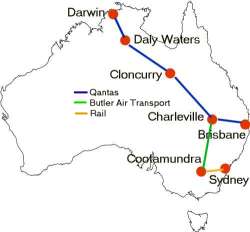
The route from Sydney was by overnight rail to Cootamundra and then on the following day by Butler Air Transport to Charleville in a DH 84 Dragon where the mail was transferred to the Qantas Empire Airways flight which had left Brisbane earlier that day.
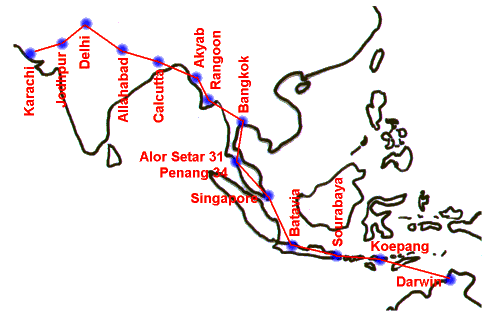
Darwin to Karachi
QEA had intended to use a DH 86A Express, but due to two recent crashes, these planes had been grounded. As they could not use their DH 86A aircraft, in early flights the Darwin - Singapore section was flown by Imperial Airways.
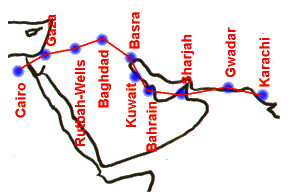
From Karachi, the flight was along the Arabian side of the Persian Gulf to Basra and then on to Cairo.
From Cairo, the mail was taken to Alexandria
in a Short S17 Kent flying boat to Athens and then
Brindisi in Southern Italy.
The mail was then taken by rail to Paris and then flown from Paris
to Croydon Airport near London.
Flights from NZ to UK in 1935
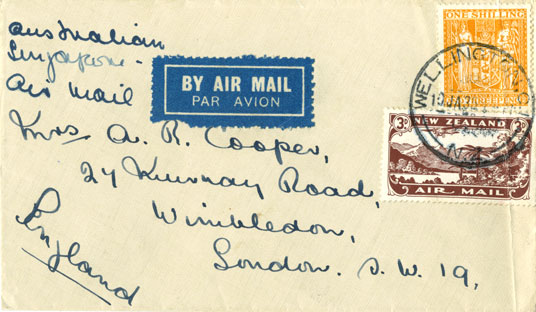
Darwin - Singapore flight by IA, January 1935
This cover is postmarked in Wellington on 10 January 1935 which is when the mail closed to be carried on the SS Monowai leaving Wellington on Thursday 10 January and arriving in Sydney on Sunday 13 January [5]. It would then have left Sydney by overnight train on the night of 15 January and connected with the service IW 305 that had left Brisbane on 16 January. It was flown to Darwin by Qantas and from there by Imperial Airways. The flight arrived in London on 28 January [2].
Although the long term plan was for the Darwin - Singapore leg
to be flown by Qantas, in early flights that leg was flown by
Imperial Airways due to the problems with the DH 86A Express aircraft.
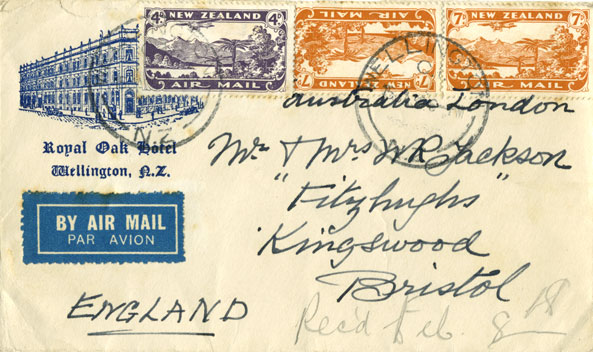
Experimental Darwin - Singapore flight by Qantas
According to Walker [1], Qantas did not take over the Darwin to Singapore leg until the flight which left Brisbane on 25 February. However, Wingent [2] reports that Lloyd's List does not report a 25 Feb flight and that Qantas first flew the Darwin to Singapore leg a month earlier in the DH 86 Melbourne on the service IW 307 that left Brisbane on 23 January.
This cover has a Wellington postmark of 15 January where the mail closed on 17 January for the SS Wanganella which left Wellington on Thursday 17 January and arrived in Sydney on Sunday 20 January and connected with IW 307. The flight arrived in London 3 days late on 7 February which ties in with the manuscript Rec'd Feb 8th on the front.
This must have been an experimental flight because, according to Wingent [2],
the next few flights from Darwin were again by Imperial Airways with the
beginning of the regular service by Qantas starting with the
flight that left Brisbane on 20 February.
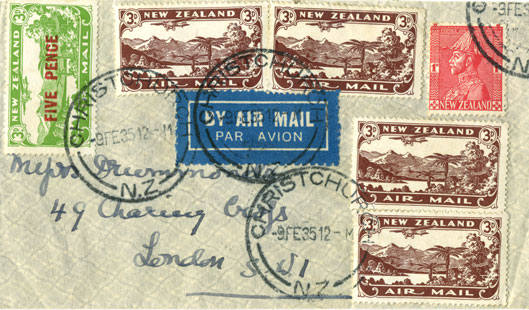
First Regular Darwin - Singapore flight by Qantas, February 1935
This cover is postmarked in Christchurch on 9 February 1935. It would have been sent to Sydney on the SS Wanganella which left Wellington on Friday 15 February and arrived in Sydney on 18 February [5].
From Sydney it would go on the overnight train to Cootamundra and connect at Charleville with IW 315 that left Brisbane on 20 February and arrived in London on 5 March. That was the beginning of Qantas regularly flying the Darwin - Singapore leg.
In fact, on this occasion, Qantas flew through to Alor Star in the
DH 86 Melbourne [2].
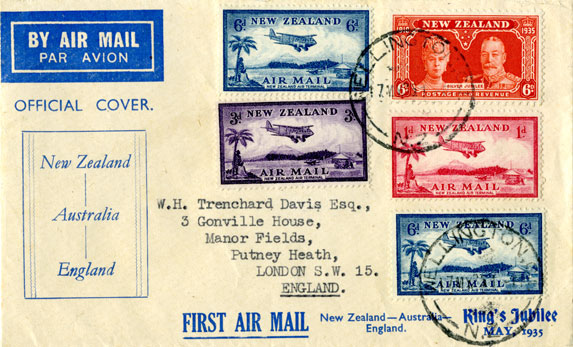
Cancelled Jubilee flight, May 1935
This next cover was to have been flown on the first official airmail flight from New Zealand to the UK on 17 May 1935.
However, due to the problems with Kingsford Smith's flight to New Zealand, the flight was cancelled and the leg to Australia was from Wellington on 17 May on the Monowai, arriving in Sydney on 20 May [5] and flown to the UK on service IW 341 that left Brisbane on 22 May and arrived in London on 3 June.
The cover has a franking of 1s 10d, but it should have been 2s 1d to
include the extra cost of 7d for the intended
trans-Tasman flight.
New airmail stamps had been issued on
4 May in time for this flight.
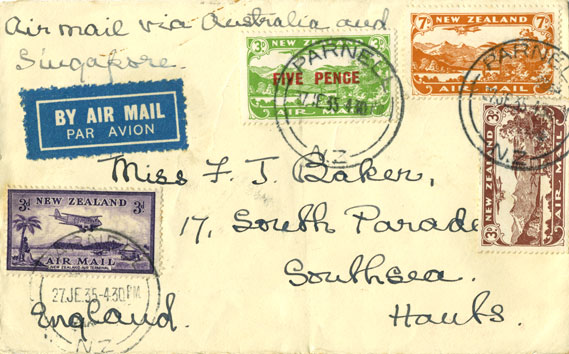
June 1935
The next is postmarked 27 June 1935 in Parnell, a suburb of Auckland. It shows an attractive mix of the two different airmail sets of stamps and has the correct franking of 1s 6d.
It was sent on the Monowai from Auckland to Sydney on 28 June - 1 July and then connected
with the Qantas service IW 353 that left
Brisbane on 3 July and arrived in London on 15 July [2].
Quadruple rate, September 1935
The large number of stamps on this cover total 6s which is four times the normal rate and so it presumably carried heavy documents. As it is postmarked 13 September 1935, the second pictorial stamps must all have a single watermark.
The Evening Post reports that the next connecting steamer to Sydney for air mail to the UK was the Marama from Auckland on 20 September with the mail closing in Wellington on 19 September [5]. It was due in Sydney on 24 September and would connect with flight IW 377 which left Brisbane on 25 September and arrived in London on 7 October.

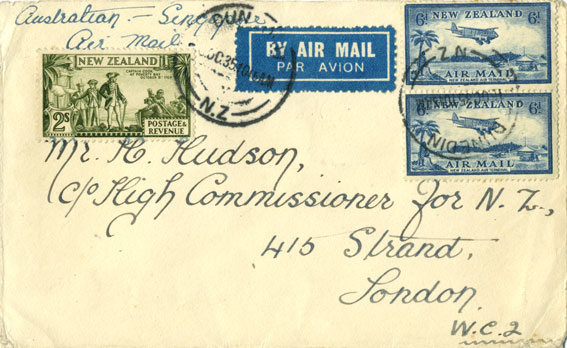
Double rate, October 1935
This cover is postmarked in the morning of 16 October in Dunedin and so may have been sent from Auckland on the Marama on 18 October. If so, it would have been flown on service IW 385 that left Brisbane on 23 October.
For this flight, the weather in the Mediterranean was so bad that the mail was held up for two days in Alexandria and subsequently sent from Athens to Paris by train, arriving in London three days late on 7 November [2].
The cover is franked with 3s in stamps, double the normal
rate, and so would have been overweight.
Flights to UK in 1936
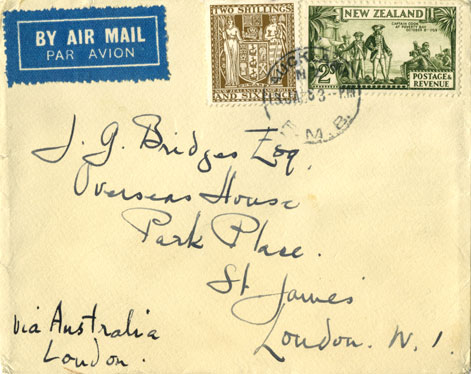
Triple rate, January 1936
The next cover is postmarked in Auckland on 13 January 1936 and is backstamped in London on 5 February. It was sent from Auckland to Sydney on the Waitaki connecting with service IW 411 that left Brisbane on 22 January. It arrived two days late.

It is unusual in that it has franking of 4s 6d, i.e. three times the normal rate.
The service between the UK and Australia became twice a week from
May 1936.
It continued at the postal rate of 1s 6d until
the Third Stage of the Empire
Airmail Scheme started in July 1938
and the rate was reduced to 1½d.
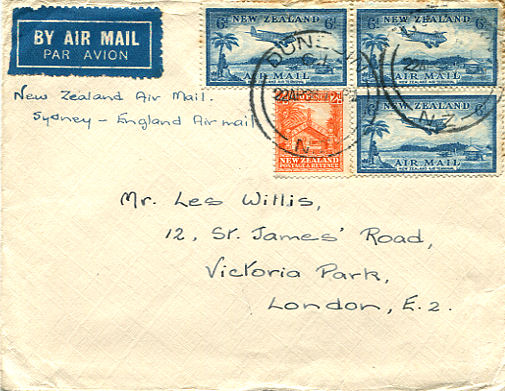
Also flown by internal air mail, April 1936
On 16 March 1936, Union Airways started a regular air mail service from Dunedin to Palmerston North via Christchurch and Blenheim. Palmerston North to Auckland was by rail. From Blenheim there was an air mail service by Cook Strait Airways to Wellington.
Mail for the UK could be flown by this internal air mail service to obtain a better connection with the trans Tasman steamer to Sydney. The cost was 1s 7d rather than 1s 6d to cover the cost of the internal air mail.
This cover to London is postmarked in Dunedin at 7 pm on 22 April 1936, is franked with 1s 8d, and has the routing instructions New Zealand Air mail / Sydney - England Air mail to show that it was also to be flown on the internal air mail service. The cost of the airmail service from Dunedin to Palmerston North was 2d, and so the sender either misunderstood that only the 1d internal airmail fee was required in addition to the 1s 6d or the additional 1d was a late fee.
The next trans-Tasman sailing was the Wanganella from Auckland on 24 April. The connecting surface mail closed in Dunedin on the morning of 22 April while the connecting air mail closed at 10.15 am on 23 April and so the internal air mail service was required in order to make the connection [8].Scipio crash, August 1936
The Short S17 Kent flying boat Scipio crashed on landing in Mirabella Bay, Crete on 22 August 1936. It was carrying mail on the Alexandria - Brindisi leg of the Imperial Airways Australia - England airmail service.
Mail left Wellington on the Marama on Friday 7 August and arrived in Sydney on Tuesday 11 August [5]. It would then have left Sydney by overnight train on 11 August to connect with flight IW 470 that left Brisbane on 12 August [2]. On August 22, the Scipio left Alexandria bound for Brindisi with the first stop being at Mirabella in Crete. Two passengers were killed in the crash when the plane sank in Mirabella Bay after landing in rough seas.
The following cover was amongst the salvaged mail. The stamps have floated off, but the letters N Z can be seen in the remains of the postmark.
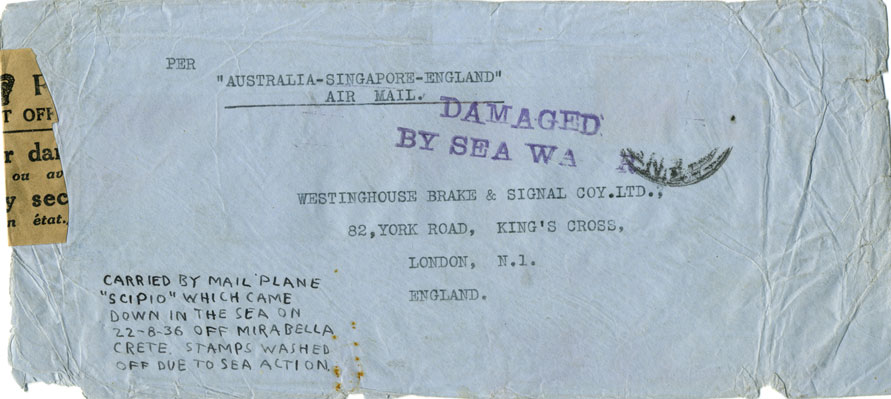
The salvaged mail was taken to Athens. Some of the mail was flown directly in London while the remainder was sent by rail to Paris and flown to London from there. The arrival dates were 25 and 27 August respectively.
The cachet DAMAGED BY SEA WATER was applied in London. A large number of different cachets exist. (Sanford [1] shows examples of a dozen applied in London together with others applied at other European destinations.) The cachets are usually in black or purple.

An official Post Office strip of brown gummed paper was attached to secure the letter. It has a London datestamp showing 27 August.
Other destinations: to Philippines 1936

This registered cover is postmarked in Greytown on 3 October 1936 and is addressed to Zamboanga in the Philippines.
It is franked with 2s 0d which would include 3d registration fee. The airmail rate to Singapore was only 9d, but the fee to non-empire countries was 1s 9d.
There is fine array of transit marks.
It has a Sydney transit mark on 12 October and so it would have been sent on the Wangella from Auckland
to Sydney on 7 - 12 October.

It would then have been flown to Singapore on service IW 488 that had left Brisbane on 14 October and arrived in Singapore on 17 October. There is a Singapore transit on that date.
From Singapore, it would have been sent by sea to Manila where a transit mark was added on 22 October. There is then an arrival mark in Zamboanga on 25 October.
A cover from the USA to New Zealand via the Philippines is shown here.
It may have been sent from the Philippines to New Zealand on the reverse of the route described above,
but the route is not clear as there are no transit marks.
Other destinations: to / from Malaya 1936

Malaya, October 1936
This cover is postmarked in Rumerua (Auckland) on 13 October 1936 and is addressed to Kuala Lumpur which was then in the Federated Malay States.
The air mail postage from New Zealand to Malaya was 9d and so the cover is correctly franked.
It was sent from Auckland to Sydney on 16 - 19 October on the Awatea
and then flown on flight IW 490 that left Brisbane on
21 October and arrived in
Singapore one day early on 24 October [2].
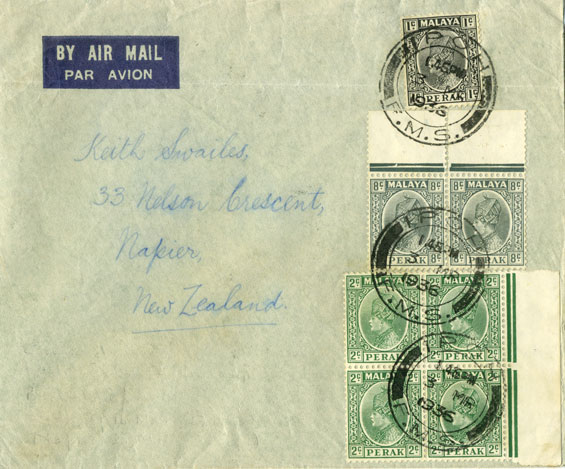
From Perak, March 1936
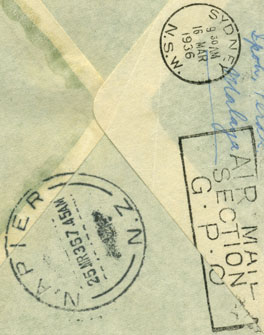
Cover posted in Ipoh in Perak in the Federated Malay States on 3 March 1936. It is correctly franked with 25c.
It was flown on service IE 423 that left Penang on 9 March and Singapore on 10 March. That service arrived in Brisbane one day late on 13 March with the Sydney mail being offloaded earlier in the day at Charleville. The mail would be expected to arrive in Sydney on 14 March, but the backstamp is not until 16 March that suggests that there was a further delay in the last part of its journey.
It has an arrival mark in Napier at 7.45 am on 25 March.
According to [5], it missed the connection at Sydney for the Monowai which left Sydney on 13 March
which explains why there is a 9 day gap between the Sydney and Napier backstamps.
As there was quite a gap before the next normal trans-Tasman steamer,
it was carried on the Kalwarra from Sydney to Picton arriving there on 23 or 24 March.
Other destinations: offloaded in Paris 1935
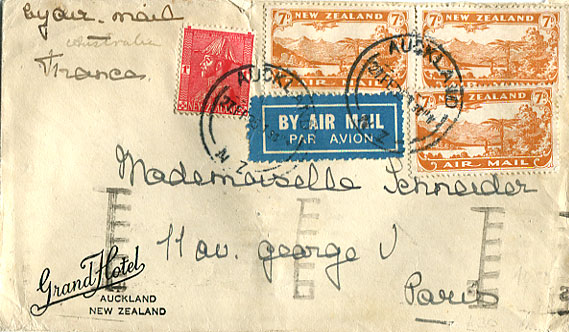
France, 1935
Cover postmarked in Auckland on 27 February 1935 addressed to Paris and franked with 1s 10d. The rate to France was 1s 9d, but the extra 1d may be a late fee.
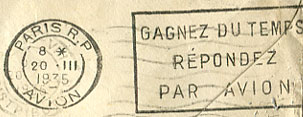
It was carried on the Franconia leaving Wellington on 28 February for Sydney [5]. It connected with IW 319 that had left Brisbane on 6 March and arrived in Paris on 20 March where it was backstamped.
There was a rebellion in Greece in early March and the previous flight
was diverted via Malta.
The rebellion was over by the time
this cover reached the Mediterranean and so it went on the normal route via Athens [2].

Netherlands, 1935
This cover is addressed to Holland and has the routing instructions via Australia France Air Mail. It is postmarked on 20 November, 1935 and left Wellington for Sydney on the Wanganella on 21 November [5]. It connected with IW 395 which had left Brisbane on 27 November and arrived in Paris on 9 December [2] which is the date on the Paris transit mark.
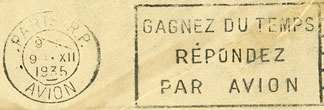
It is franked with 1s 9d which is the rate for airmail being offloaded in Paris and then carried by surface postage from Paris to Holland - the rate was 2s 1d if it was flown on that final stage.
At this time, the Brindisi - Paris leg of the Imperial
Airways service was by rail and so it is
interesting that the Pais transit mark includes the term Avion
even though the cover both arrived and left Paris by rail.
Other destinations: offloaded in Greece 1935-1936
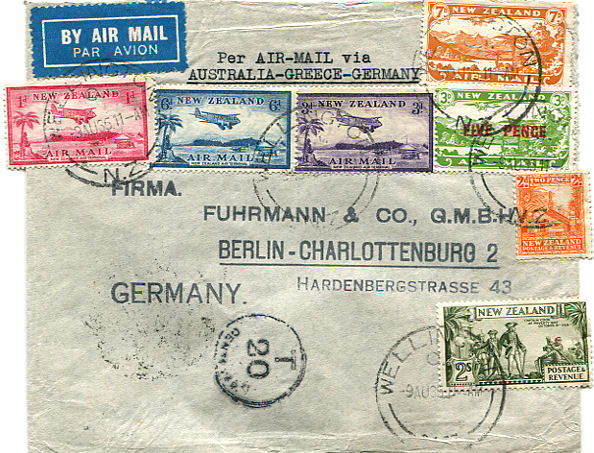
Germany, 1935
This cover is Postmarked in Wellington at 11am on 9 August 1935 and is addressed to Berlin. It would have been sent Wellington - Sydney on 9 - 13 August on the Marama. The Wellington mails for this sailing closed at 1pm on 9 August [5].
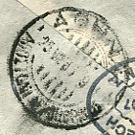
It has the routing instructions Australia - Greece - Germany and was backstamped on 25 August in Athens after being offloaded from the Imperial Airways flight IW 365 which had left Brisbane on 14 August and arrived in Athens one day late on Sunday 25 August [2].
It would then be flown Athens - Salonica on 26 August by the Greek air company S.H.C.A. (Societe Hellenique de Communications Aeriennes) and Salonica - Berlin by Deutsche Lufthansa [7].
It is franked with 4s 0d. As the rate to Germany was 2s 1d for the first ½oz and 2s 0d for each subsequent ½oz, it is a double weighted cover underfranked by 1d. That explains the T 20 centimes handstamp which corresponds to 2d to pay as the amount was always double the deficiency.
Several of the stamps overlap the cover and were originally 'wrapped round' and
partially gummed on to the back.
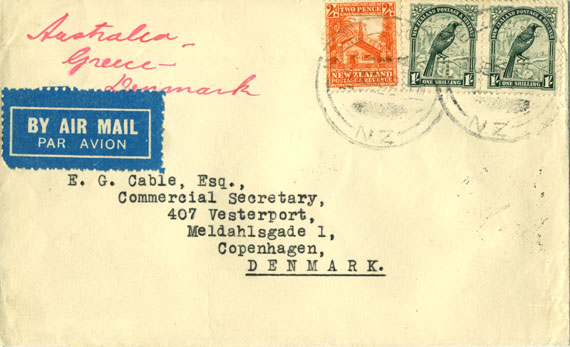
Denmark, 1936
This cover is addressed to Copenhagen and has the routing instructions Australia - Greece - Denmark. It is franked with 2s 2d which is the correct rate for the route [2] where it was offloaded from the Imperial Airways flight at Athens and flown through Europe from there.

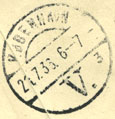
The Wanganella left Wellington on 30 June and was due in Sydney on 3 July. It might have been thought that it would connect with IW 459 that left Brisbane on 4 July, but the backstamps show that this cover connected with IW 460 which left Brisbane on 8 July and arrived in Athens on Saturday 18 July.
The cover is backstamped in Athens on 18 July and
in Copenhagen on 21 July.
It would have been flown from Athens to Berlin by Deutsche Lufthansa on Monday
20 July and from Berlin to Copenhagen on 21 July [6].

The next cover to Denmark is postmarked 18 December 1936 and has the routing instructions: Australia - London - Copenhagen. The cover has franking of 1s 11½d and, as the rate to Denmark via London was 1s 9d, it carries sufficient postage. However, it has a postage due T imprint with 50 centimes to pay.
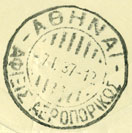
The cover has a Greek transit postmark dated 7 January 1937 on the back and so was offloaded at Athens and flown by the same route as the previous cover. As that rate was 2s 2d, the cover was deemed to be underfranked by 2½d which corresponds to the postage due of 50 centimes.
It was carried Wellington - Sydney on the Awatea on 21 - 24 December and connected with IW 509 that left Brisbane on 26 December and arrived in Athens two days late on 7 January [2]. It would then be flown from Athens to Copenhagen via Berlin on 8 -9 January [7].
So, the postal authorities sent the cover by a more expensive route
than the routing instructions and then compounded their mistake
by adding a surcharge!
Other origins: from Dutch East Indies July 1935
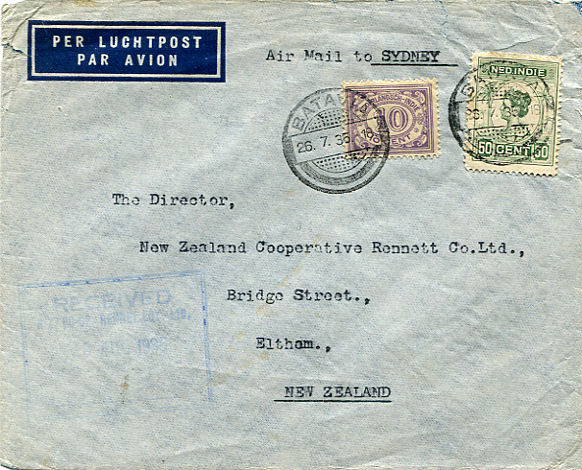
This commercial cover is postmarked in Batavia on 26 July 1935 and is addressed to Eltham which is south of New Plymouth in the North Island. It is franked with 60 cents.

It has a Sydney transit mark on 3 August and so would have been flown on IE 359 that left Batavia on 30 July. There is a faint Received handstamp on the front that appears to be dated 15 August.
The mail from IE 359 arrived in Auckland on 13 August on the Kalingo
which date fits with the Received handstamp. [5].
Other origins: from USA September 1935
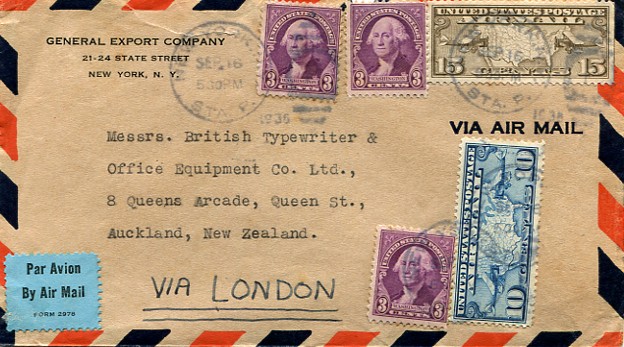
Cover postmarked in New York on 16 September 1935 and addressed to Auckland with routing instructions Via London.
It would be sent by sea across the Atlantic and then flown by BOAC / Qantas to Sydney before being sent by sea across the Tasman to New Zealand.
The postage rate was 44c air mail plus 5c surface postage.
The cover is franked with 34c and so is underfranked by 15c.
The circular datestamp on the 10c stamp is incomplete and so it is likely
that a 15c stamp has been removed from the cover to the right of the 10c stamp.
Pity, as otherwise, it is a very nice cover.
Other origins: from Africa 1936
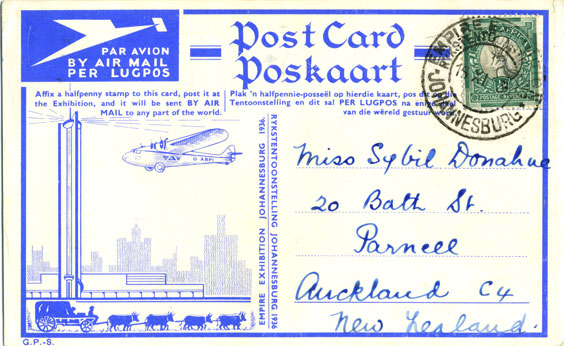
From Empire Exhibition, Johannesburg, November 1936

The Empire Exhibition was held in Johannesburg from October 1936 to January 1937. Souvenir postcards could be puchased and posted at the Exhibition where they would then be sent by airmail to anywhere in the world at a cost of a halfpenny.
This card to New Zealand was posted on 16 November and is backstamped in Sydney at 6.30 am on 4 December. It would have been flown from Johannesburg to Cairo where it would connect with the Eastern Route flight IE 499 to Australia which left Alexandria on 25 November. It would then be carried on the Awatea from Sydney to Wellington on 4 - 7 December.
Apparently, 365 postcards were sent to New Zealand from the Exhibition out of a total of 29,307 cards, two thirds of which were sent internally in South Africa or to the UK [4].
The cost of a letter from South Africa to New Zealand was 1s 8d while a postcard was 10d and so
there was a significant price reduction.
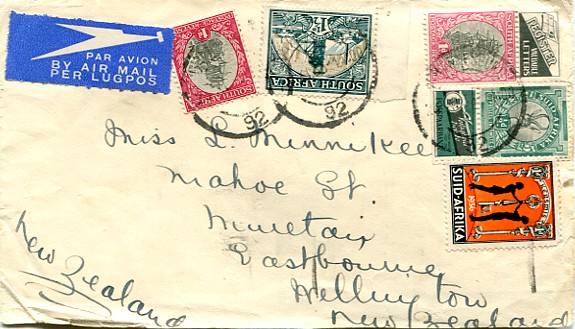
Double Rate from South Africa, November 1936
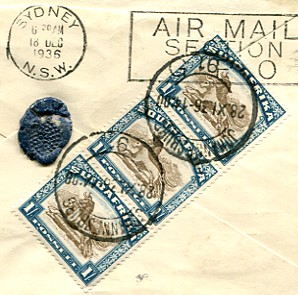
Cover postmarked in Johannesburg on 28 November 1936, franked with 3s 4d, double the rate of 1s 8d. Backstamped in Sydney at 6.20 a.m. on 18 December.
African mail left Johannesburg on 2 December and arrived in Alexandria on 7 December.
IE 503 left Alexandria on 9 December and
arrived in Charleville on 17 December with mail flown to Cootamundra by Butler Air Transport and and then
by overnight train to Sydney.
Introduction of flying boats
From February 1937, The London - Alexandria leg was by flying boat which meant that the only stage in the journey from London that was not flown was the final stage from Cootamundra to Sydney.
All scans were made by the author.
[1] Airmails of New Zealand, volume 2 (1986) compiled by
Douglas A Walker, and
The New Zealand Airmail Catalogue, (2nd Edition, 1994)
by James Stapleton.
Both are published by the
Air Mail Society of New Zealand
[2] Aircraft Movements on Imperial Airways' Eastern Route,
Vol 1, 1927 - 1937, Peter Wingent, Winchester 1999.
[3] Aircraft Movements on Imperial Airways' Eastern Route,
Vol 2, 1937 - 1939, Peter Wingent, Winchester 2005.
[4] The Cheapest Airmail Rate in the World?, Air Mail News, vol 51,
pp 7 - 13, May 2008.
[5] Evening Post Wellington 1916-1945, Papers Past,
available at: paperspast.natlib.govt.nz/cgi-bin/paperspast
[6] airline timetable images available at: www.timetableimages.com
[7] The D.L.H. Athens - Berlin Service, Peter Wingent, Imperial Airways Gazette,
pp 29-47, June 2005.
[8] Also Flown by New Zealand Internal Air Mail, R Clark, Air Mail News, vol 60,
pp 27-34, August 2017.